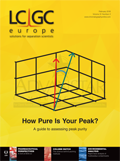How to Avoid Problems in LC–MS
Five tips to avoid common problems in LC–MS
Five tips to avoid common problems in LC–MS
Liquid chromatography–mass spectrometry (LC–MS) analyses are becoming much more prevalent in all areas of analytical research. However, this technique is often seen as being very complex requiring a high level of operator skill. While this may be true, a little bit of basic understanding and practical insight into this powerful technique will allow LC–MS methods to be successfully implemented. Here are five tips to help you get the most out of your LC–MS instrument and methods.
Tip One: Contamination
You should always be thinking about contamination because it affects both the method (for example, poor results caused by signal suppression) and the instrument (such as involatile components contaminating the ion source, which will result in more user maintenance). A must do for reducing contamination is to use a divert valve; this simple valve fitted between the high performance liquid chromatography (HPLC) and MS systems allows you to introduce only peaks of interest into the MS and divert t0 and the high organic portion of the gradient. Everything you inject into the HPLC system will enter the mass spectrometer to build contamination. Another invaluable tip is to try to avoid introducing as much contamination as possible into the LC–MS by carrying out sufficient sample preparation for your samples; simple filtration may suffice for relatively clean samples with little endogenous matrix components; however, for complex samples more robust methods such as solid-phase extraction (SPE) may be required to remove dissolved contaminants.
Tip Two: Volatile Mobile Phase
Control of pH is critical to so many aspects of LC–MS, hence, it is essential that your mobile phase contains components that control the pH. At the very least employ a volatile acid (0.1% formic acid) or base (0.1% ammonium hydroxide, if the column is rated to high pH), but ideally a buffer (10 mM ammonium formate) adjusted to a specified pH (2.8 or 8.2). Any additives that are used should be volatile to avoid contamination of the ion source (for example, use formate or acetate buffers and not phosphate). Some additives cause signal suppression, such as trifluoroacetic acid, for example; formic acid can be a good alternative if sensitivity cannot be sacrificed. Furthermore, all additives should be of the highest possible purity. Use the lowest amount of the required additive possible to reduce background noise (10 mM or 0.05% v/v is a good place to start). Here’s a good mantra for
LC–MS: If a little bit works, a little bit less probably works better.
Tip Three: Benchmarking Method
Have a benchmarking method and generate data when the instrument is working. This approach is an absolute must for troubleshooting and should be your first step when a problem does occur. Five replicate injections of a compound, such as reserpine, which can be used to assess parameters such as retention time, repeatability, or peak height, is ideal. At the first sign of problems run the benchmarking method; if this method works, the problem is related to your method or samples and not the instrument. If you find that the benchmark does not work then the problem is with the system.
Tip Four: Infusion
Although there are some general rules related to LC–MS ionization it should always be presumed that this technique is compound dependent. Therefore, during method development you should always perform an infusion and optimize LC and MS parameters to provide the optimum signal for your analyte; these parameters include mobile-phase pH, ionization mode and polarity, and MS source settings such as voltages, flow rates, and temperatures. An autotune followed by a manual tune on your analytes should provide the optimum signal. Keep an individual tune file for each group of compounds. When tuning key parameters that can generate a response curve (such as electrospray ionization source voltages, flow rates, or temperatures), setting the value to a maximum may not give you the most robust method-instead set values on a maximum plateau where small changes in that particular variable will not produce a large change in instrument response.
Tip Five: Don’t Vent Too Frequently
Mass spectrometers are at their most reliable when they are left running. Venting the instrument increases wear and risks damage to many components. An expensive component particularly prone to damage through venting is the turbo pump, which is designed to operate at high vacuum. When switching on the vacuum for the first time there is a rush of atmospheric air that places a high amount of strain on the turbo vanes and particularly the bearings, which greatly accelerates the wear on the turbo.
Get the full tutorial at www.CHROMacademy.com/Essentials (free until 20 March).

Characterizing Plant Polysaccharides Using Size-Exclusion Chromatography
April 4th 2025With green chemistry becoming more standardized, Leena Pitkänen of Aalto University analyzed how useful size-exclusion chromatography (SEC) and asymmetric flow field-flow fractionation (AF4) could be in characterizing plant polysaccharides.
Investigating the Protective Effects of Frankincense Oil on Wound Healing with GC–MS
April 2nd 2025Frankincense essential oil is known for its anti-inflammatory, antioxidant, and therapeutic properties. A recent study investigated the protective effects of the oil in an excision wound model in rats, focusing on oxidative stress reduction, inflammatory cytokine modulation, and caspase-3 regulation; chemical composition of the oil was analyzed using gas chromatography–mass spectrometry (GC–MS).










